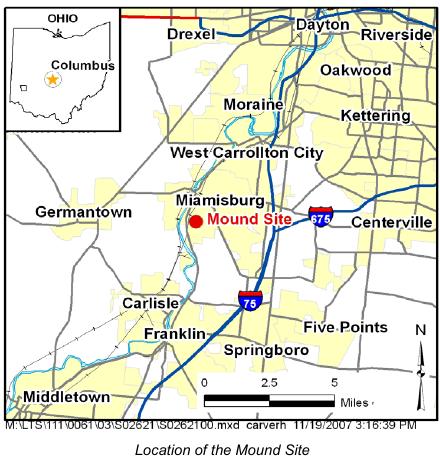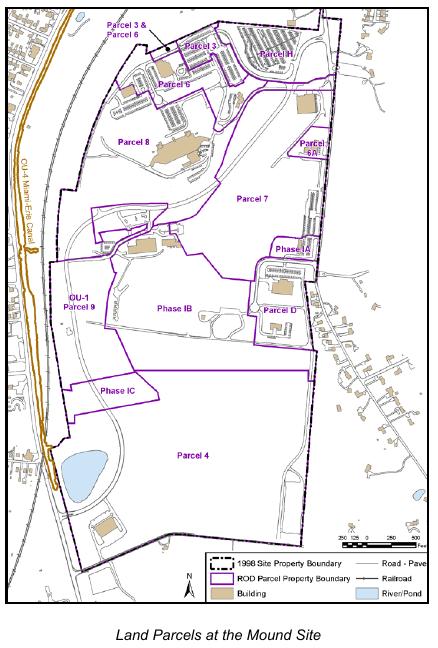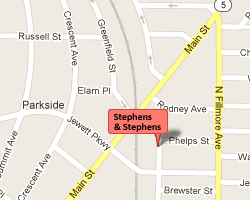Mound Plant
Also Known As: MOUND, Monsanto Research Corp., Miamisburg Environmental Management Project (MEMP), Dayton Project, Mound Plant, Miamisburg Closure Project
State: Ohio
Location: Miamisburg
Time Period: 1947- present
Facility Type: Department of Energy
Facility Description
In 1943, the Manhattan Engineer District began the Dayton Project to investigate the chemistry and metallurgy of polonium. Between 1943 and 1948, this work was performed at locations around Dayton, all of which turned out to be too small for the job. As such, the Mound Plant was constructed in 1947 in Miamisburg, Ohio to replace these earlier laboratories. Mound was first occupied in May 1948 and became operational February 1949.
The Mound Plant’s first mission was to manufacture polonium-beryllium initiators for atomic weapons. As part of this process, the site extracted polonium-210 from irradiated bismuth slugs and machined beryllium parts. Mound stopped producing initiators after the Pinellas Plant in Florida began producing accelerator-type neutron generators in 1957. In 1954, Mound began developing and producing weapons components containing tritium, and in 1969, the plant began recovering and purifying tritium from dismantled nuclear weapons. During the 1950s and 1960s the Mound Plant also developed and produced a variety of nonnuclear weapons components including detonators, cable assemblies, firing sets, ferroelectric transducers, and explosive timers. In 1995, Mound discontinued weapons component production.
The Mound Plant has also performed nonweapons work. The site developed and manufactured radioisotope thermal generators and conducted research in the following areas: radioactive waste decontamination; the properties of uranium, protactinium-231, and plutonium-239; and separation of stable isotopes and noble gases. Mound continues to produce thermal generators which are used for remote power applications including space probes.
Throughout the course of its operations, the potential for beryllium exposure existed at this site, due to beryllium use, residual contamination, and decontamination activities.
CONTRACTORS: CH2M Hill(2003-present); BWX Technologies (1997- 2002); EG&G Mound Applied Technologies (1988-1997); Monsanto Chemical Company (1947-1988)
Listing
Mound Plant is listed as a Department of Energy (DOE) site under the EEOICPA.
Special Exposure Cohort (SEC) Classes
Employees of the Department of Energy (DOE), its predecessor agencies, and DOE contractors or subcontractors who worked in any areas at the Mound Plant site from October 1, 1949, through February 28, 1959, for a number of work days aggregating at least 250 work days or in combination with work days within the parameters established for one or more other classes of employees in the SEC
(Note: This class was established from Petition 90)
All employees of the Department of Energy (DOE), its predecessor agencies, and its contractors and subcontractors who had at least one tritium bioassay sample and worked at the Mound Plant in Miamisburg, Ohio from March 1, 1959 through March 5, 1980, for a number of work days aggregating at least 250 work days, occurring either solely under this employment, or in combination with work days within the parameters established for one or more other classes of employees in the Special Exposure Cohort
(Note: This class was established from Petition 171)
All employees of the Department of Energy, its predecessor agencies, and their contractors and subcontractors who worked at the Mound Plant in Miamisburg, Ohio, from September 1, 1972, through December 31, 1972, or from January 1, 1975, through December 31, 1976, for a number of work days aggregating at least 250 work days, occurring either solely under this employment or in combination with work days within the parameters established for one or more other classes of employees in the Special Exposure Cohort
(Note: This class was established from Petition 207)
Compensation
As of 08/23/2015, the total compensation paid under Parts B and E of the EEOICPA, including medical compensation, for workers suffering from the effects of having worked at the Mound Plant is $131,126,843.
Mound Plant Workers
If you or your parent worked at this or any other DOE or AWE facility and became ill, you may be entitled to compensation of up to $400K plus medical benefits from the US Department of Labor. Call EEOICPA Counsel Hugh Stephens at 1-855-EEOICPA (336-4272) or fill out the form to the right, whether or not you have already filed a claim and even if your claim has been accepted or denied.
We can help with all OWCP (Federal Workers Compensation) claims, impairments, wage loss and health care. 2495 Main Street, Suite 442 Buffalo, NY.
*Site Description and History
The Mound site in Miamisburg, Ohio, named for a nearby Native American burial ground, is located approximately 10 miles southwest of Dayton, Ohio. The Great Miami River flows southwest through the city of Miamisburg and dominates the geography of the region surrounding the site. The region is a mix of farmland, residential area, small communities, and light industry. Many residential developments, five schools, the Miamisburg downtown area, and six city parks are located within a mile of the site.
Much of the site sits atop an elevated area overlooking the City of Miamisburg, the Great Miami River, and the river plain area to the west. Site elevations vary from 700 to 900 feet above sea level.
The Mound site, which operated from 1948 to 2003 as part of the U.S. Atomic Energy Commission and later the U.S. Department of Energy (DOE), was built to continue Dayton, Ohio’s Manhattan Project work on polonium-beryllium initiators used in early atomic weapons. The site expanded into an integrated research, development, and production facility supporting weapons, energy, and space missions. Weapons and energy operations included separation and sale of stable isotopes, calorimetry, and neutron radiology; plastics, ceramics, and metallurgy; explosives and pyrotechnics; cable assemblies, detonators, and electronic firing sets; recovery of tritium for reuse; and research on fossil fuels. Space mission support included development of radioisotopic thermoelectric generators that provided electrical power for National Aeronautics and Space Administration space exploration programs including Voyager I and II, Galileo, and many others.
The site grew from the original 182 acres into 305 acres in 1983 when DOE purchased an undeveloped area south of the original property. At its peak the facility encompassed 116 buildings and employed over 2,500 highly skilled workers.


Videos
Further history of the Mound Plant can be seen below:
DOCUMENTS
NIOSH SEC Petition Evaluation Reports
Petition 90 (Feb 1, 1949 to Present)
SEC Petition Evaluation Report, Petition SEC-00090, Rev #: 0
Report Submittal Date: December 19, 2007
Petition 91 (Feb 1, 1949 to Present)
Merged with Petition 90
Petition 171 (Mar 1, 1959 to Mar 5, 1980)
SEC Petition Evaluation Report, Petition SEC-00171, Rev #: 0
Report Submittal Date: May 4, 2010
Petition 207 (Sep 1 to Dec 1972; 1975-1976)
SEC Petition Evaluation Report, Petition SEC-00207, Rev #: 0
Report Submittal Date: September 6, 2012
Technical Basis Documents
Site Profile
Mound Site – Introduction, Revision: 01
Effective Date: 03/28/2013
Mound Site – Site Description, Revision: 01
Effective Date: 04/01/2013
Mound Site – Occupational Medical Dose, Revision: 02
Effective Date: 03/14/2013
Mound Site – Occupational Environmental Dose, Revision: 01
Effective Date: 02/07/2013
Mound Site – Occupational Internal Dose, Rev. 03
Effective Date: 03/03/2017
Technical Basis Document for the Mound Site – Occupational External Dosimetry, Revision No.: 00
Effective Date: 08/11/2004
SC&A
SC&A’S REVIEW OF REMAINING SITE PROFILE ISSUES FOR MOUND LABORATORY RELATED TO CURRENT TECHNICAL BASIS DOCUMENTS
February 2016
NIOSH RESPONSE: REVIEW OF REMAINING SITE PROFILE ISSUES FOR MOUND LABORATORY
Effective Date: 4/27/2016
Share this:
EEOICPA CLAIMS
If you or your parent worked any of the DOE or AWE facilities listed on this website and became ill, you may be entitled to compensation of up to $400K plus medical benefits from the US Department of Labor.
Call EEOICPA Counsel Hugh Stephens at 1-800-548-4494, email hstephens@stephensstephens.com, or fill out the form below whether or not you have already filed a claim and even if your claim has been accepted or denied.
Contact Us
"*" indicates required fields
*note: Submission of this form does not establish an attorney-client privilege.
Contact Us
Address:
2495 Main Street, Suite 442
Buffalo, New York 14214
Phone:
(716) 852-7590
Fax:
(716) 852-7599
After Hours:
(716) 208-3525
Email Us:
R. William Stephens, Esq.
R. Hugh Stephens, Esq.
Lisa P. Neff, Esq.

